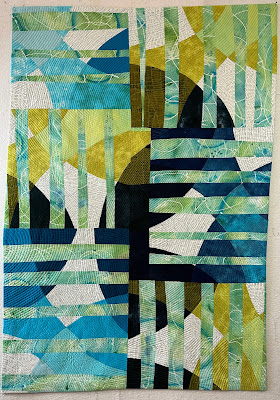I found a picture that I wanted to use for my Garden Lady series. This is #4. It'll be named when it is complete.
The inspiration is from a watercolor designed by Lois Dahl. It really spoke to me and the artist gave me permission to use it as an inspiration for my garden lady series. I loved the ethereal nature and all the green shades and flowers in this piece.
I traced around it and had it blown up to 50" H at the Rose City blue print shop in Portland, Oregon. There was a huge "For Lease" sign in the front. I looked panicky when I got up to the counter, but the people there assured me that they were not closing, but that they had gotten close to it before negotiations made it possible for them to stay. (It is run by only 2 people). This is my absolute favorite place to get my sketches blown up. They are quick, courteous, privately held, and very inexpensive. I don't know where I'd take my sketches if they closed. Anyway, here is the pattern from the print shop.
For the shirt, I collaged hand dyed material, lace hem tape, rick-rack, organza, thread and Angelina fibers; all in multiple colors. I quilted it with pale green thread, cut it out with the pattern on top and turned under the edges. Here are some progress pictures.
Layering the materials on an off white batik.
Showing the quilting on the back side of the sleeve.
Sewing the pattern to top of the collaged sleeve.
More detail on the layers of the body of the shirt.
The shirt with the sleeve pinned onto the pattern.
A pile of the components. Angelina fibers, 3 colors of organza, purple and green hand dyed material, antique rick-rack and hem tape. Not included is the thread that was snipped and dropped into place.
I hope you like the progress so far!













































.jpg)
.jpg)
.jpg)





